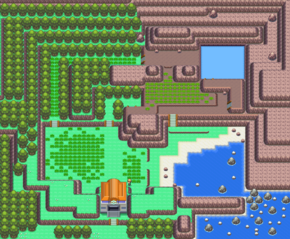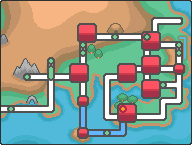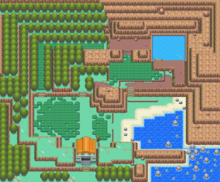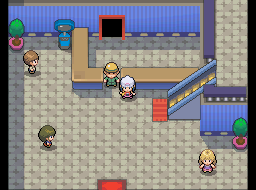Pal Park
| |||||
| |||||
| Map description: | This used to be the location of the Safari Zone, but is now the Pal Park.HGSS | ||||
|---|---|---|---|---|---|
| Location: | Route 221, Fuchsia City | ||||
| Region: | Sinnoh | ||||
| Generations: | IV | ||||
 Location of Pal Park in Sinnoh. | |||||
| Pokémon world locations | |||||
Pal Park (Japanese: パルパーク Pal Park) is a special Pokémon preserve present in the five Generation IV main series games, located at the east end of Route 221 in Sinnoh and in Fuchsia City in place of the Safari Zone in Kanto.
The purpose behind Pal Park is to allow Pokémon obtained in the Generation III games to be transferred forward to Generation IV through use of the Nintendo DS's Game Boy Advance slot. Early in Generation IV, this was the only manner in which legendary Pokémon and starter Pokémon introduced before Generation IV, as well as Tangela, Tangrowth, and Tropius could be obtained, as they were unavailable in Pokémon Diamond and Pearl. Pokémon Platinum remedied this somewhat, with the expanded Sinnoh Pokédex and post-National Pokédex roaming legendary birds, though it was not until Pokémon HeartGold and SoulSilver that all non-event Pokémon could be obtained with only the Generation IV games.
According to Professor Oak, Pal Park attracts Pokémon from other regions. To use Pal Park, a player must transfer six Pokémon from a Generation III game of the same language as the Generation IV game using a Nintendo DS or DS Lite. Therefore, migrations from Japanese Generation III cartridges into English or another other non-Japanese Generation IV cartridges is impossible since the games would not recognize them as Pokémon games. However, a Pokémon from a third generation cartridge can be transferred into a fourth generation Pokémon game cartridge of another language if it was traded into another third generation game cartridge of the same language as the fourth generation one and can then be migrated from there. After the Pokémon have been transferred, the player may opt to play the game on a Nintendo DSi, DSi XL, or 3DS to recatch them in Pal Park itself, though due to these units' lack of a Game Boy Advance slot, the Pokémon transfer must take place on another system.
Pal Park's slogan is "A Place for New Beginnings". This references its role as the beginning of the post-League section of Pokémon Diamond and Pearl, and the "new beginning" a transferred Pokémon will have.
Accessing Pal Park
In Diamond, Pearl, and Platinum, players can travel to Pal Park as soon as they have obtained HM03 (Surf) and earned the Relic BadgeDP or Fen BadgePt. Access will be denied, however, until all the Pokémon in the Sinnoh Pokédex have been seen and the National Pokédex has been obtained. Until this is achieved, the construction workers outside will mention that Pal Park will be opening soon. Once the National Pokédex has been obtained, Professor Oak will meet the player on Route 221 and invite the player inside the building. He will briefly explain how Pal Park works, as well. Players will also find that the "migrate from [game]" option will appear on the main menu screen when the game is loaded, provided a GBA game is in the Nintendo DS's second slot.
Pal Park in HeartGold and SoulSilver is located where the Kanto Safari Zone was in previous games, at the north end of Fuchsia City. It is stated in-game that it used to be a Safari Zone, but when the warden closed it down, his son opened Pal Park in its place. As players cannot enter Kanto without the National Pokédex, it is also required in these games. As soon as the player has arrived in the city, the migrate option will appear on the menu screen, regardless of whether Pal Park has been visited or not.
Principle
Purpose
- Main article: List of Pokémon by Pal Park location
Pal Park allows people who have both the Generation III and Generation IV games to transfer Pokémon ahead via the Nintendo DS's Game Boy Advance slot. In Diamond, Pearl, and Platinum the number of transfers per day is limited to one per 24 hour period per GBA cartridge. It is possible to manipulate this to allow multiple transfers, however, no further migrations can be made until all six Pokémon transferred have been caught. The time restriction has been removed in HeartGold and SoulSilver. The player may choose to leave the park at any time; however, they must then re-capture all migrated Pokémon on a subsequent visit.
Pal Park was previously the only way in which players could complete their Pokémon collections in Diamond, Pearl, and Platinum. Following the release of HeartGold and SoulSilver, all non-event Pokémon can be obtained within the Generation IV games. Pal Park remains useful though, as Pokémon trained in Generation III can be brought through onto the new games. There are also some Pokémon, such as Regice, which are only obtainable via an event in Generation IV but can be obtained normally in Generation III. Finally, there are some items that can only be obtained in Generation IV through Pal Park.
Function

Unlike in Generation II, where the Time Capsule allowed Pokémon to return to Generation I, the transfer from Generation III to Generation IV is permanent—all Pokémon sent over are removed from the GBA games and cannot be returned.
In a similar fashion to the Time Capsule, though, there is a move requirement on the Pokémon to be transferred: Pokémon moving from Generation III to Generation IV must know no HM moves from Generation III. These moves can be deleted before transfer in Lilycove City or Fuchsia City. This created some controversy, with players being unable to transfer special event Pikachu who knew Surf or Fly as well as many Pokémon that lost the ability to learn Dive in Generation IV. However, when Pokémon Platinum was released, those Pokémon who lost Dive could learn it again via Move Tutor.
After Pokémon have been imported from the GBA game in the bottom slot of the DS through the main menu of the Generation IV game, they may be captured in Pal Park through an event known as a Catching Show. Each Pokémon has a specific area of the park that they reside in, and therefore, they must also be found before they can be received. Pal Park uses a special type of Poké Ball known as a Park Ball, which has a 100% capture rate, much like the Master Ball. Once a battle begins, there are only two commands that can be used - Throw Ball, or Run. Throwing a Park Ball at the Pokémon will capture it with a 100% capture rate; running away will escape from the battle.
After a Pokémon is captured, if its status screen is viewed, it will display the region that it was originally captured in, Hoenn for Pokémon Ruby, Sapphire, and Emerald (even if it was caught on Navel Rock, Birth Island or Faraway Island); Kanto for Pokémon FireRed and LeafGreen (even if it was captured in an area of the Sevii Islands); and "distant land" for Colosseum and XD. It will also display the level at which the Pokémon was migrated.
Everything will stay the same, such as OT, ID number, item held, Pokérus if the Pokémon has it, and even the original type of Poké Ball used to capture the Pokémon, despite a Park Ball being used to recapture it.
The spots of Spinda will stay the same as well as whatever Forme of Deoxys was transferred. Deoxys Formes can later be changed at each one of the meteorites in Veilstone City in Diamond, Pearl, and Platinum and on Route 3 in HeartGold and SoulSilver.
Score
In addition to transferring Pokémon from Generation III, Pal Park also has a score system that will offer rewards depending on the player's score. The score will be given at the end of the Catching Show by the Park Ranger. The score is worked out by how fast the captures are completed and what Pokémon are transferred over. If a rarer or a legendary Pokémon is migrated, such as Mewtwo, a higher score will be given, as opposed to more common Pokémon such as Rattata, which will be given a lower score. Timing will also alter the score: if it takes longer to complete the challenge the score will be decreased; however, if it takes a shorter amount of time to complete the challenge, the score will be increased. When Pal Park is first visited, a default high score of 2000 will be set by the player's rival (either Barry in the Sinnoh games or Silver in the Johto games). The Park Ranger always gives the player a Berry as a reward; the higher the score, the rarer the Berry.
Rewards
Manipulation
Despite the game having settings in place to restrict the amount of Pokémon migrated in a single day, these restrictions can be avoided and an infinite number of Pokémon transferred into Generation IV. If, once a Catching Show has been completed, the player turns off the game system and changes the date on the Nintendo DS to show one day later, and inserts a second Generation III game, he or she will be instructed to reset the time on the DS. This will prevent migration from the second game, but allow the original game—that has already had six Pokémon transferred—to send Pokémon into Diamond, Pearl, or Platinum. Also, one can set the DS's clock to the time displayed in the GBA cartridge before choosing Pal Park option to avoid the 24 hour period of waiting before transferring their Pokémon.
Geography
Lobby
Pal Park is a large area consisting of a large park and a small entry building. Entering the building will take the player into the lobby, where they can accept to take part in the Daily Catching Show by talking to the Park Ranger. There are two floors in the lobby. The first is where registration for the show takes place. One woman on the left side of the building will tell the player their highest score achieved in the Catching Show, another will give the player two Pokétch apps, the Kitchen Timer and Color Changer by showing her a Snorlax and a Kecleon respectively. The second floor is accessible using the stairs on the right. Many people come up here to see all of the shows, as there are glass windows from which the entire park can be seen. In total, there are seven people within the lobby.
In HeartGold and SoulSilver, Pal Park is located in Fuchsia City, replacing the Safari Zone from Generations I and III. It holds almost exactly the same function as Sinnoh's Pal Park. It is available as soon as the player arrives in Fuchsia City, as the player already has the National Pokédex by then.
Park
Pal Park itself is a huge park, with different terrains to suit all sorts of different Pokémon. Upon entering, the player will begin in the field area of Pal Park. This contains a large open space with large patches of tall grass, inhabited by field Pokémon. There are two patches of grass within the area, a small patch on the east, and a larger patch on the west. There are 123 Pokémon that can appear in this area. There are three different paths the player can take in order to get to the another area of the park; the north-western stairway will take the player to the forest area, the north-eastern stairway will take the player through a pathway to the mountain area, and traveling east will take the player to the sea area by jumping off a ledge.
By following the path up the far north-western side of the park, the player will reach the forest area of Pal Park, where forest-dwelling Pokémon live. There are 74 Pokémon that can appear in this area. It is a long, narrow strip of pathway following up the far western side of the park, then it takes a right turn up in the corner of the park, and travels east until the player reaches the pond area. The path is a long, narrow, dark pathway covered by tall trees, with the ground covered all the way by tall grass. The only other way to get to and from the forest area is by traveling through the pond area. When the player reaches the pond area via the forest area, the player must travel a short distance east to reach the pond, a pool of water, able to be surfed across, where all the wild Pokémon inhabit. There are 37 Pokémon that can appear in this area. If the player travels south while getting there, they will find a ledge going down into the mountain area. Once entering the square pond to find Pokémon, they can go south to reach dry land, where they can also climb up and down stairs on the steep mountainside to reach the sea area. Alternatively, the player can enter from the sea area by traveling north through part of the mountain area to reach the southern part of the waterside, where the player can surf across the light water to the other side. There is no other way of getting to the pond in the north-eastern corner.
The mountain area is located in the middle of a mountainside, in the center of Pal Park. It can be accessed by jumping a ledge in the pond area just north of there, or going through a little forest pathway from the field area. The mountain area has a small patch of grass, where the player can find wild Pokémon. There are 105 Pokémon that can appear in this area. Most of this area is covered with grass, while only a small part of it isn't. There is also a ledge the player can jump down to reach the sea area. This is the only way to leave the area apart from turning back to the field area. The final area in the park, known as the sea area, is found in the south-eastern corner of the park. It can be accessed by going east from the field area, or south from the mountain area, by jumping down the ledge and going down the mountainside. The sea area makes up a large section of the park, with a large area of sea coming in from the west. When the player enters from the mountain or pond area, there is a large ledge to a sandy beach where the sea meets the land. The area also has rocky terrain, with many rocks on the beach and in the water blocking the way, so that the player cannot travel any further east past the mountain side. By surfing across the deep blue water, the player can encounter many different types of wild sea Pokémon. In total, there are 37 Pokémon that can appear in this area. If the player goes west past another set of ledges, they will end up back on the eastern side of the field area where they began, making a big loop.
Items
| Item | Location | Games | |
|---|---|---|---|
| Park Ball ×6 | Given by the Park Ranger to capture the six Pokémon in the Catching Show; cannot be kept afterwards. | D P Pt HG SS | |
| Crown | Given by a girl in the lobby if Pokémon FireRed is in the GBA slot. | D P Pt HG SS | |
| Tiara | Given by a girl in the lobby if Pokémon LeafGreen is in the GBA slot. | D P Pt HG SS | |
| Trainer Counter | Given by Professor Oak upon entering Pal Park. | D P Pt | |
| Kitchen Timer | Given by a woman in the lobby after showing her a Snorlax. | D P Pt | |
| Color Changer | Given by a woman in the lobby after showing her a Kecleon. | D P Pt | |
| Underground | Given by a girl in the lobby if Pokémon Ruby is in the GBA slot | D P Pt HG SS | |
| Seafloor | Given by a girl in the lobby if Pokémon Sapphire is in the GBA slot | D P Pt HG SS | |
| Sky | Given by a girl in the lobby if Pokémon Emerald is in the GBA slot | D P Pt HG SS | |
Name origin
The English and Japanese names are based on the word "pal", an affectionate term for a friend. Other language versions use a similar naming style, although the German- and French-language versions are less colloquial and translate to Park of (the) Friends.
Trivia
- If the player uses a walk through walls cheat in Sinnoh, they can access an area behind Pal Park building. It is identical to the first few tiles seen when entering Pal Park to perform in a catching show. The only Pokémon that will appear are those which reside in Route 221, where the Pal Park is situated.
- Changing the Nintendo DS clock or playing the game on another Nintendo DS system will delay Pal Park Catching Show for 24 hours.
- Pal Park shares its background music with the resident Safari Zones in the games it appears in, using that of Johto's in HeartGold and SoulSilver, and using that of the Great Marsh in Diamond, Pearl, and Platinum. This is somewhat fitting considering it replaces the Kanto Safari Zone in HeartGold and SoulSilver, though the Kanto Safari Zone theme is the same as the trading and evolution theme.
- Even though Kanto is visitable in HeartGold and SoulSilver and Pal Park is located there, Pokémon transferred over from FireRed and LeafGreen have location data set as "Kanto", rather than the area in Kanto they were caught in. This is due to the fact that the Generation IV game does not read Generation III location data at all - only the game in which the Pokémon was first generated.
- This also means that if an Egg is created in a Hoenn-based game and traded to a Kanto-based game before it is hatched, or vice versa, the Pokémon would display the name of the region it was generated in, rather than the one it was hatched in, even though its OT and ID number is that of the game it was hatched in.
- Although Pal Park is a West Sinnoh location in Diamond, Pearl, and Platinum, it uses East Sinnoh trees.
- Because there were no Korean Generation III games, Pal Park in Korean Generation IV games can transfer Pokémon from a Generation III game of any language.
- Prior to the release of Platinum, using Pal Park was the only way to legitimately obtain Tangela and Tropius in Diamond and Pearl. This is notable because they are neither legendary nor starter Pokémon, as was the case with all other Pokémon who could only be legitimately obtained through Pal Park.
In other languages
| |||||||||||||||||||||
See also
| Sinnoh | ||||||||
|---|---|---|---|---|---|---|---|---|
|
| ||||||||
|
| Kanto | ||||||||
|---|---|---|---|---|---|---|---|---|
|
| ||||||||
|

|
This article is part of Project Locations, a Bulbapedia project that aims to write comprehensive articles on every location in the Pokémon world. |





